Potential of CO2 Emission Reduction via Application of Geothermal Heat Exchanger and Passive Cooling in Residential Sector under Polish Climatic Conditions
Abstract
1. Introduction
2. Materials and Methods
2.1. The Installation and the Building
2.2. Simulations and Calculations
3. Results and Discussion
4. Conclusions
Author Contributions
Funding
Institutional Review Board Statement
Informed Consent Statement
Data Availability Statement
Conflicts of Interest
References
- IEA. The Future of Colling; IEA: Paris, France, 2018; Available online: https://www.iea.org/reports/the-future-of-cooling (accessed on 22 January 2022).
- Larsen, M.A.D.; Petrović, S.; Radoszynski, A.M.; McKenna, R.; Balyk, O. Climate Change Impacts on Trends and Extremes in Future Heating and Cooling Demands over Europe. Energy Build. 2020, 226, 110397. [Google Scholar] [CrossRef]
- Werner, S. European Space Cooling Demands. Energy 2016, 110, 148–156. [Google Scholar] [CrossRef]
- Tsvetkov, O.B.; Laptev, Y.A. Refrigerants and Environment. J. Phys. Conf. Ser. 2017, 891, 012218. [Google Scholar] [CrossRef]
- IEA. Cooling Emissions and Policy Synthesis Report; IEA: Paris, France, 2020; Available online: https://www.iea.org/reports/cooling-emissions-and-policy-synthesis-report (accessed on 22 January 2022).
- Zhang, T.; Zhai, Y.; Feng, S.; Tan, X.; Zhang, M.; Duan, L.; Shi, Q.; Meng, J.; Hong, J. Does It Pay to Develop a Ground Source Heat Pump System? Evidence from China. J. Environ. Manag. 2022, 305, 114378. [Google Scholar] [CrossRef] [PubMed]
- Todorov, O.; Alanne, K.; Virtanen, M.; Kosonen, R. A Novel Data Management Methodology and Case Study for Monitoring and Performance Analysis of Large-Scale Ground Source Heat Pump (GSHP) and Borehole Thermal Energy Storage (BTES) System. Energies 2021, 14, 1523. [Google Scholar] [CrossRef]
- Dimplex Podręcznik Projektowania. Ogrzewanie i Chłodzenie Pompą Ciepła; Glen Dimplex Deutschland GmbH: Poznań, Poland, 2006; Available online: https://dimplex24.pl/dokument/ogrzewanie-i-chlodzenie-pompa-ciepla (accessed on 23 January 2022).
- Maddah, S.; Goodarzi, M.; Safaei, M.R. Comparative Study of the Performance of Air and Geothermal Sources of Heat Pumps Cycle Operating with Various Refrigerants and Vapor Injection. Alex. Eng. J. 2020, 59, 4037–4047. [Google Scholar] [CrossRef]
- Fidorow-Kaprawy, N.; Stefanowicz, E. Analysis of the Power Extraction Rate Change for Boreholes in Time and in Different Heat Load Conditions. E3S Web Conf. 2019, 116, 00021. [Google Scholar] [CrossRef]
- Szulgowska-Zgrzywa, M.; Fidorów-Kaprawy, N. Performance Analysis of a Brine-to-Water Heat Pump and of Its Boreholes’ Temperature Change during Three Years of Operation. Appl. Therm. Eng. 2017, 127, 233–244. [Google Scholar] [CrossRef]
- Rubinová, O.; Ambrožová, I.; Horák, P. Long-Term Monitoring of the Effectiveness of a Ground Source Heat Pump Borehole. Adv. Mater. Res. 2014, 1041, 125–128. [Google Scholar] [CrossRef]
- Reda, F.; Arcuri, N.; Loiacono, P.; Mazzeo, D. Energy Assessment of Solar Technologies Coupled with a Ground Source Heat Pump System for Residential Energy Supply in Southern European Climates. Energy 2015, 91, 294–305. [Google Scholar] [CrossRef]
- Reda, F.; Laitinen, A. Different Strategies for Long Term Performance of SAGSHP to Match Residential Energy Requirements in a Cold Climate. Energy Build. 2015, 86, 557–572. [Google Scholar] [CrossRef]
- Miglani, S.; Orehounig, K.; Carmeliet, J. Integrating a Thermal Model of Ground Source Heat Pumps and Solar Regeneration within Building Energy System Optimization. Appl. Energy 2018, 218, 78–94. [Google Scholar] [CrossRef]
- Radomski, B.; Drojetzki, L.; Mróz, T. Integration of a Heat Exchanger on the Supply Air with the Ground-Source Heat Pump in a Passive House—Case Study. IOP Conf. Ser. Earth Environ. Sci. 2019, 214, 012087. [Google Scholar] [CrossRef]
- Mohammadzadeh Bina, S.; Fujii, H.; Tsuya, S.; Kosukegawa, H. Comparative Study of Hybrid Ground Source Heat Pump in Cooling and Heating Dominant Climates. Energy Convers. Manag. 2022, 252, 115122. [Google Scholar] [CrossRef]
- Allaerts, K.; al Koussa, J.; Desmedt, J.; Salenbien, R. Improving the Energy Efficiency of Ground-Source Heat Pump Systems in Heating Dominated School Buildings: A Case Study in Belgium. Energy Build. 2017, 138, 559–568. [Google Scholar] [CrossRef]
- Reuss, M. The Use of Borehole Thermal Energy Storage (BTES) Systems. In Advances in Thermal Energy Storage Systems; Elsevier: Amsterdam, The Netherlands, 2015; pp. 117–147. [Google Scholar] [CrossRef]
- Hemmatabady, H.; Formhals, J.; Welsch, B.; Schulte, D.O.; Sass, I. Optimized Layouts of Borehole Thermal Energy Storage Systems in 4th Generation Grids. Energies 2020, 13, 4405. [Google Scholar] [CrossRef]
- Pavlov, G.; Olesen, B.W. Olesen Building Thermal Energy Storage—Concepts and Applications. In Proceedings of the 12th ROOMVENT Conference, Trondheim, Norway, 19–22 June 2011. [Google Scholar]
- Law, Y.L.E.; Dworkin, S.B. Characterization of the Effects of Borehole Configuration and Interference with Long Term Ground Temperature Modelling of Ground Source Heat Pumps. Appl. Energy 2016, 179, 1032–1047. [Google Scholar] [CrossRef]
- Kim, S.-K.; Lee, Y. Evaluation of Ground Temperature Changes by the Operation of the Geothermal Heat Pump System and Climate Change in Korea. Water 2020, 12, 2931. [Google Scholar] [CrossRef]
- Fossa, M. Correct Design of Vertical Borehole Heat Exchanger Systems through the Improvement of the ASHRAE Method. Sci. Technol. Built Environ. 2017, 23, 1080–1089. [Google Scholar] [CrossRef]
- Fossa, M.; Rolando, D. Improving the Ashrae Method for Vertical Geothermal Borefield Design. Energy Build. 2015, 93, 315–323. [Google Scholar] [CrossRef]
- Focaccia, S.; Tinti, F. An Innovative Borehole Heat Exchanger Configuration with Improved Heat Transfer. Geothermics 2013, 48, 93–100. [Google Scholar] [CrossRef]
- Spitler, J.D.; Bernier, M. Vertical Borehole Ground Heat Exchanger Design Methods. In Advances in Ground-Source Heat Pump Systems; Elsevier: Amsterdam, The Netherlands, 2016; pp. 29–61. [Google Scholar]
- Guo, Y.; Hu, X.; Banks, J.; Liu, W.v. Considering Buried Depth in the Moving Finite Line Source Model for Vertical Borehole Heat Exchangers—A New Solution. Energy Build. 2020, 214, 109859. [Google Scholar] [CrossRef]
- BniLam, N.; Al-Khoury, R.; Shiri, A.; Sluys, L.J. A Semi-Analytical Model for Detailed 3D Heat Flow in Shallow Geothermal Systems. Int. J. Heat Mass Transf. 2018, 123, 911–927. [Google Scholar] [CrossRef]
- Stefanowicz, E.; Szulgowska-Zgrzywa, M. Energy Balancing in Ground Heat Exchanger for Heat Pump Systems—A Case Study with Simulations. E3S Web Conf. 2019, 100, 00076. [Google Scholar] [CrossRef]
- Stefanowicz, E.; Piechurski, K. Przyczyny i skutki przeciążenia dolnego źródła gruntowej pompy ciepła. Rynek Instal. 2019, 27, 32–36. [Google Scholar]
- Zeng, H.; Diao, N.; Fang, Z. Heat Transfer Analysis of Boreholes in Vertical Ground Heat Exchangers. Int J Heat Mass Transf 2003, 46, 4467–4481. [Google Scholar] [CrossRef]
- Djongyang, N.; Tchinda, R.; Njomo, D. Thermal Comfort: A Review Paper. Renew. Sustain. Energy Rev. 2010, 14, 2626–2640. [Google Scholar] [CrossRef]
- Oxizidis, S.; Papadopoulos, A.M. Performance of Radiant Cooling Surfaces with Respect to Energy Consumption and Thermal Comfort. Energy Build. 2013, 57, 199–209. [Google Scholar] [CrossRef]
- d’Ambrosio Alfano, F.R.; Dell’Isola, M.; Palella, B.I.; Riccio, G.; Russi, A. On the Measurement of the Mean Radiant Temperature and Its Influence on the Indoor Thermal Environment Assessment. Build. Environ. 2013, 63, 79–88. [Google Scholar] [CrossRef]
- Mavrogianni, A.; Wilkinson, P.; Davies, M.; Biddulph, P.; Oikonomou, E. Building Characteristics as Determinants of Propensity to High Indoor Summer Temperatures in London Dwellings. Build. Environ. 2012, 55, 117–130. [Google Scholar] [CrossRef]
- Walikewitz, N.; Jänicke, B.; Langner, M.; Meier, F.; Endlicher, W. The Difference between the Mean Radiant Temperature and the Air Temperature within Indoor Environments: A Case Study during Summer Conditions. Build. Environ. 2015, 84, 151–161. [Google Scholar] [CrossRef]
- Su, L.; Li, N.; Zhang, X.; Sun, Y.; Qian, J. Heat Transfer and Cooling Characteristics of Concrete Ceiling Radiant Cooling Panel. Appl. Therm. Eng. 2015, 84, 170–179. [Google Scholar] [CrossRef]
- Koch, W. Relationship between Air Temperature and Mean Radiant Temperature in Thermal Comfort. Nature 1962, 196, 587. [Google Scholar] [CrossRef] [PubMed]
- Gao, S.; Ooka, R.; Oh, W. Formulation of Human Body Heat Transfer Coefficient under Various Ambient Temperature, Air Speed and Direction Based on Experiments and CFD. Build. Environ. 2019, 160, 106168. [Google Scholar] [CrossRef]
- de Dear, R.J.; Arens, E.; Hui, Z.; Oguro, M. Convective and Radiative Heat Transfer Coefficients for Individual Human Body Segments. Int. J. Biometeorol. 1997, 40, 141–156. [Google Scholar] [CrossRef]
- Teitelbaum, E.; Chen, K.W.; Aviv, D.; Bradford, K.; Ruefenacht, L.; Sheppard, D.; Teitelbaum, M.; Meggers, F.; Pantelic, J.; Rysanek, A. Membrane-Assisted Radiant Cooling for Expanding Thermal Comfort Zones Globally without Air Conditioning. Proc. Natl. Acad. Sci. USA 2020, 117, 21162–21169. [Google Scholar] [CrossRef]
- Li, Z.; Zhang, D.; Li, C. Experimental Study on Thermal Response Characteristics of Indoor Environment with Modular Radiant Cooling System. Energies 2020, 13, 5012. [Google Scholar] [CrossRef]
- Pisarev, V. Wentylacja i Klimatyzacja z Wykorzystaniem Belek i Sufitów Chłodzących; Oficyna Wydawnicza Politechniki Rzeszowskiej: Rzeszów, Poland, 2010; pp. 38–39. [Google Scholar]
- Poulsen, S.E.; Alberdi-Pagola, M.; Cerra, D.; Magrini, A. An Experimental and Numerical Case Study of Passive Building Cooling with Foundation Pile Heat Exchangers in Denmark. Energies 2019, 12, 2697. [Google Scholar] [CrossRef]
- Rabczak, S.; Proszak-Miasik, D. Passive Cooling in the System of a Heat Pump with a Vertical Ground Collector. IOP Conf. Ser. Mater. Sci. Eng. 2019, 603, 052094. [Google Scholar] [CrossRef]
- Szczęśniak, S.; Stefaniak, Ł. Global Warming Potential of New Gaseous Refrigerants Used in Chillers in HVAC Systems. Energies 2022, 15, 5999. [Google Scholar] [CrossRef]
- Ilisei, G.; Catalina, T.; Gavriliuc, R. Sensitivity Analysis Using Simulations for a Ground Source Heat Pump—Implementation on a Solar Passive House. E3S Web Conf. 2019, 111, 01070. [Google Scholar] [CrossRef]
- Stefanowicz, E.; Fidorów-Kaprawy, N. The Influence of the Ground Parameters’ Assumptions on the Low Enthalpy Heat Pump’s Energy Source Simulation’s Results. E3S Web Conf. 2017, 17, 00087. [Google Scholar] [CrossRef]
- Mahmoud, M.; Ramadan, M.; Pullen, K.; Abdelkareem, M.A.; Wilberforce, T.; Olabi, A.-G.; Naher, S. A Review of Grout Materials in Geothermal Energy Applications. Int. J. 2021, 10, 100070. [Google Scholar] [CrossRef]
- Kurevija, T.; Macenić, M.; Borović, S. Impact of Grout Thermal Conductivity on the Long-Term Efficiency of the Ground-Source Heat Pump System. Sustain. Cities Soc. 2017, 31, 1–11. [Google Scholar] [CrossRef]
- Dong, S.; Liu, G.; Zhan, T.; Yao, Y.; Ni, L. Performance Study of Cement-Based Grouts Based on Testing and Thermal Conductivity Modeling for Ground-Source Heat Pumps. Energy Build. 2022, 272, 112351. [Google Scholar] [CrossRef]
- Krajowy Ośrodek Bilansowania i Zarządzania Emisjami. Wskaźniki Emisyjności CO2, SO2, NOx, CO i Pyłu Całkowitego dla Energii Elektrycznej; Krajowy Ośrodek Bilansowania i Zarządzania Emisjami: Warszawa, Poland, 2021; Available online: https://www.kobize.pl/uploads/materialy/materialy_do_pobrania/wskazniki_emisyjnosci/Wskazniki_emisyjnosci_grudzien_2021.pdf (accessed on 1 October 2022).
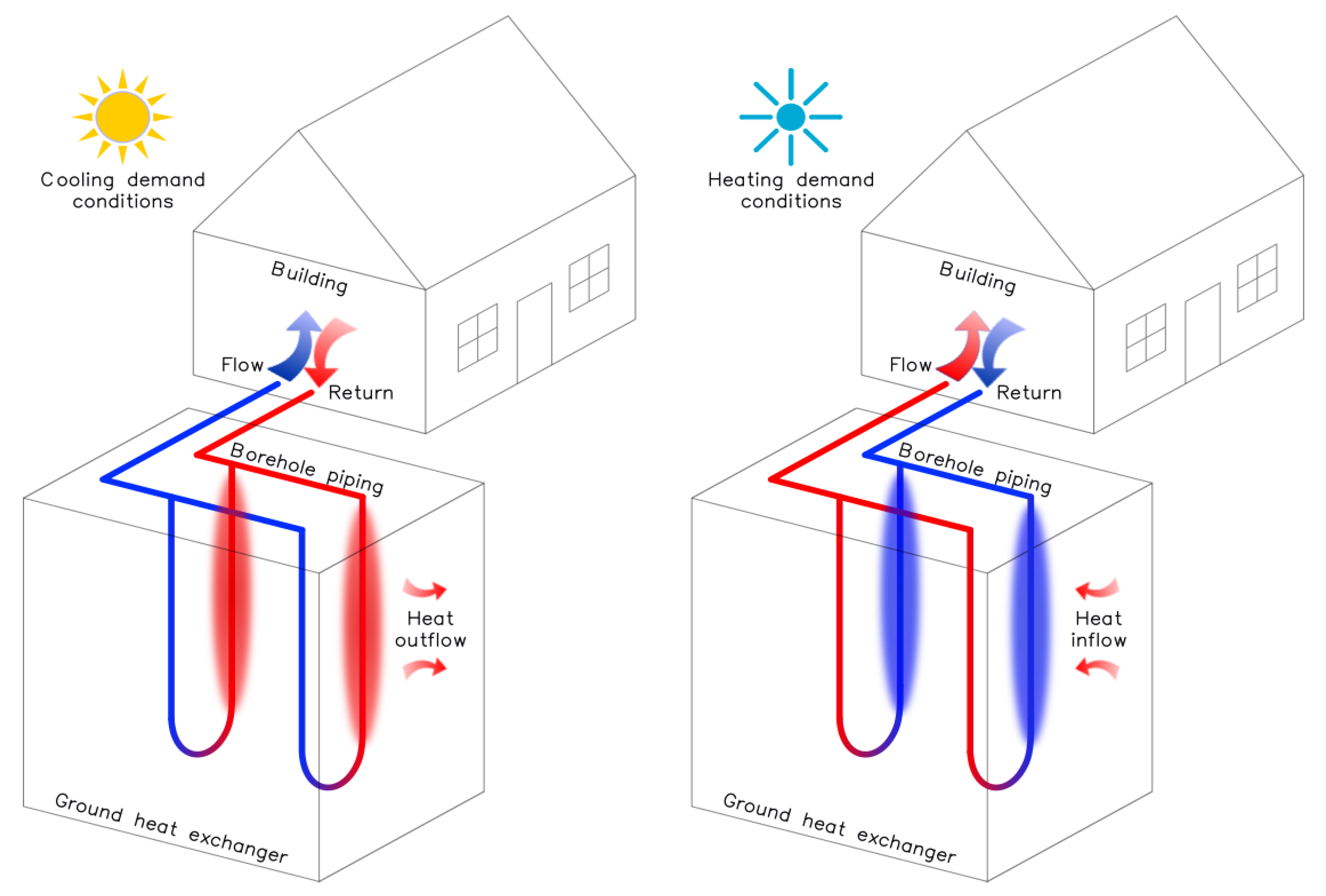

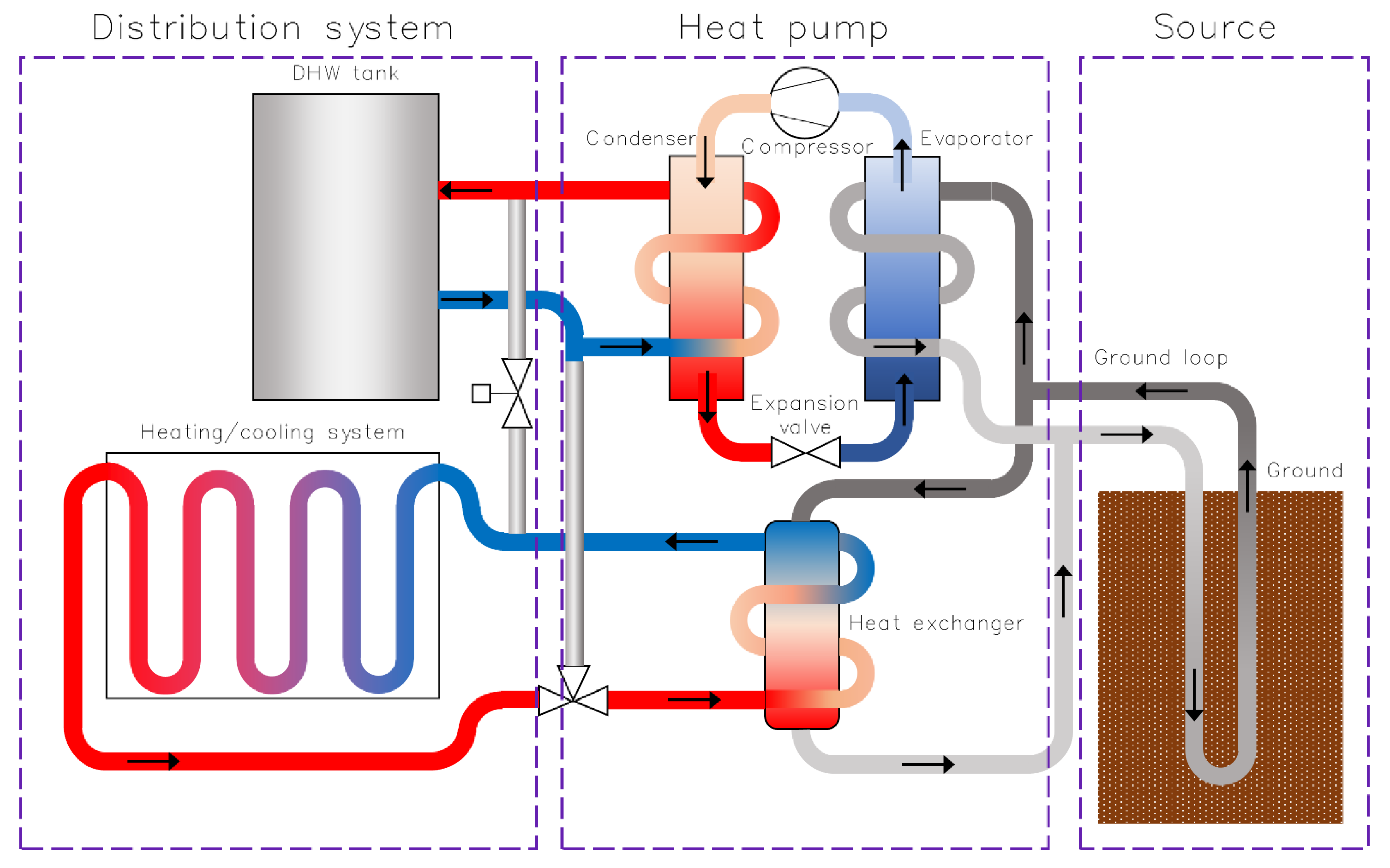

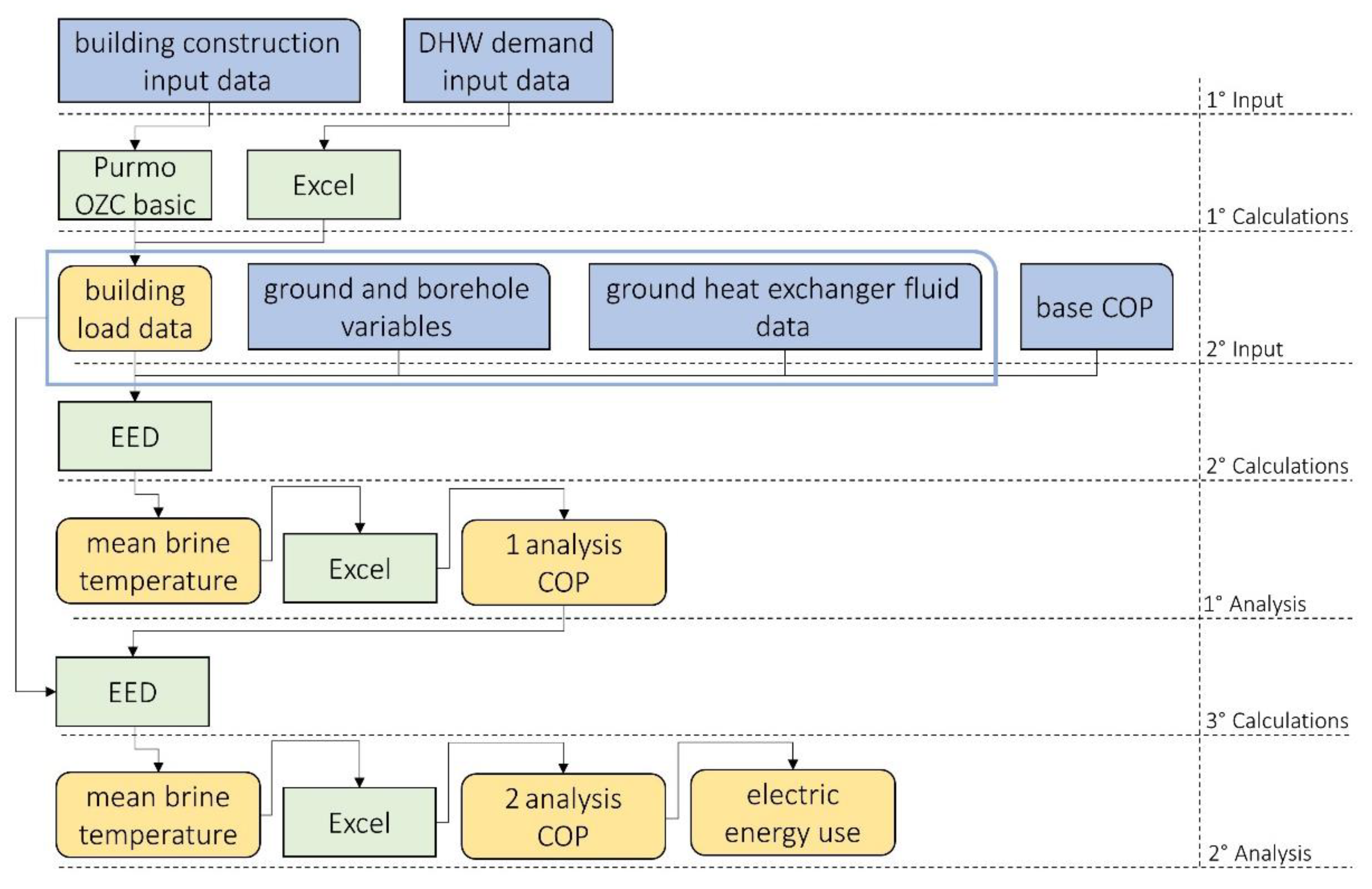
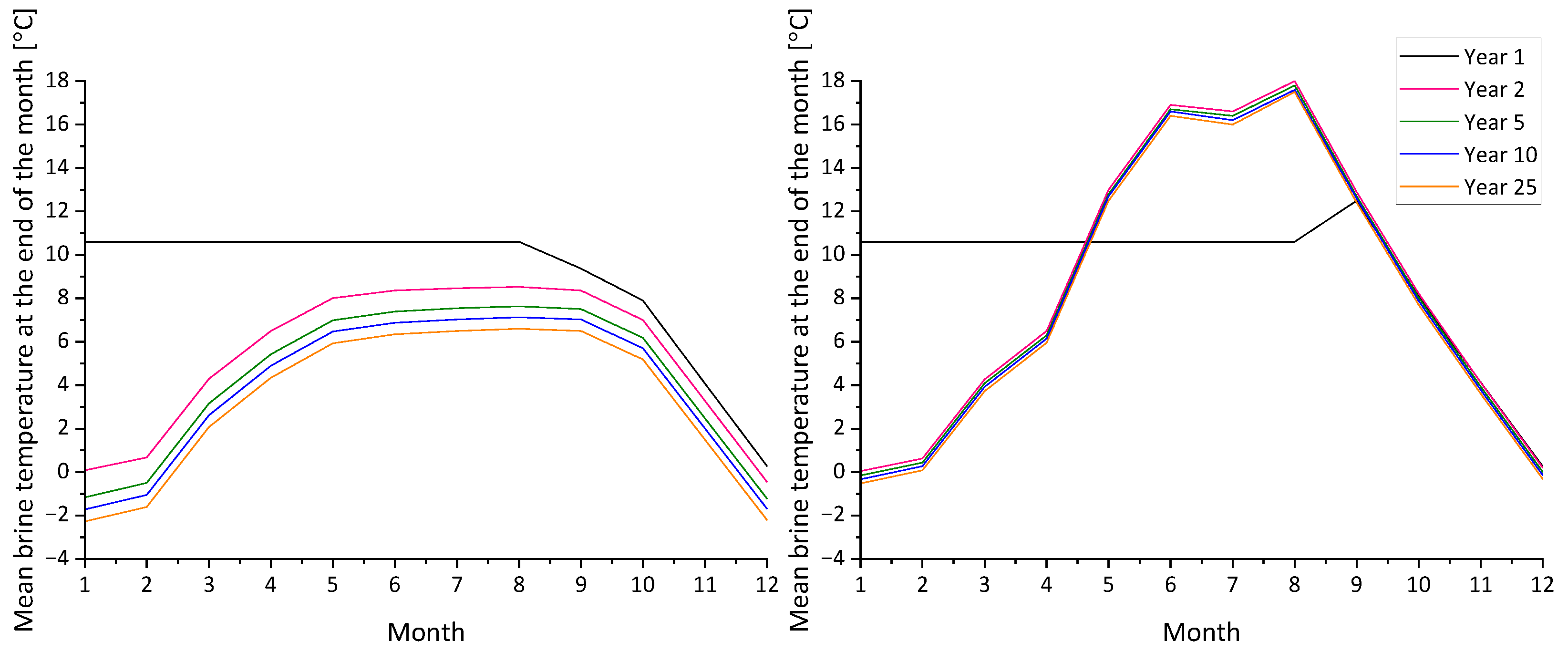


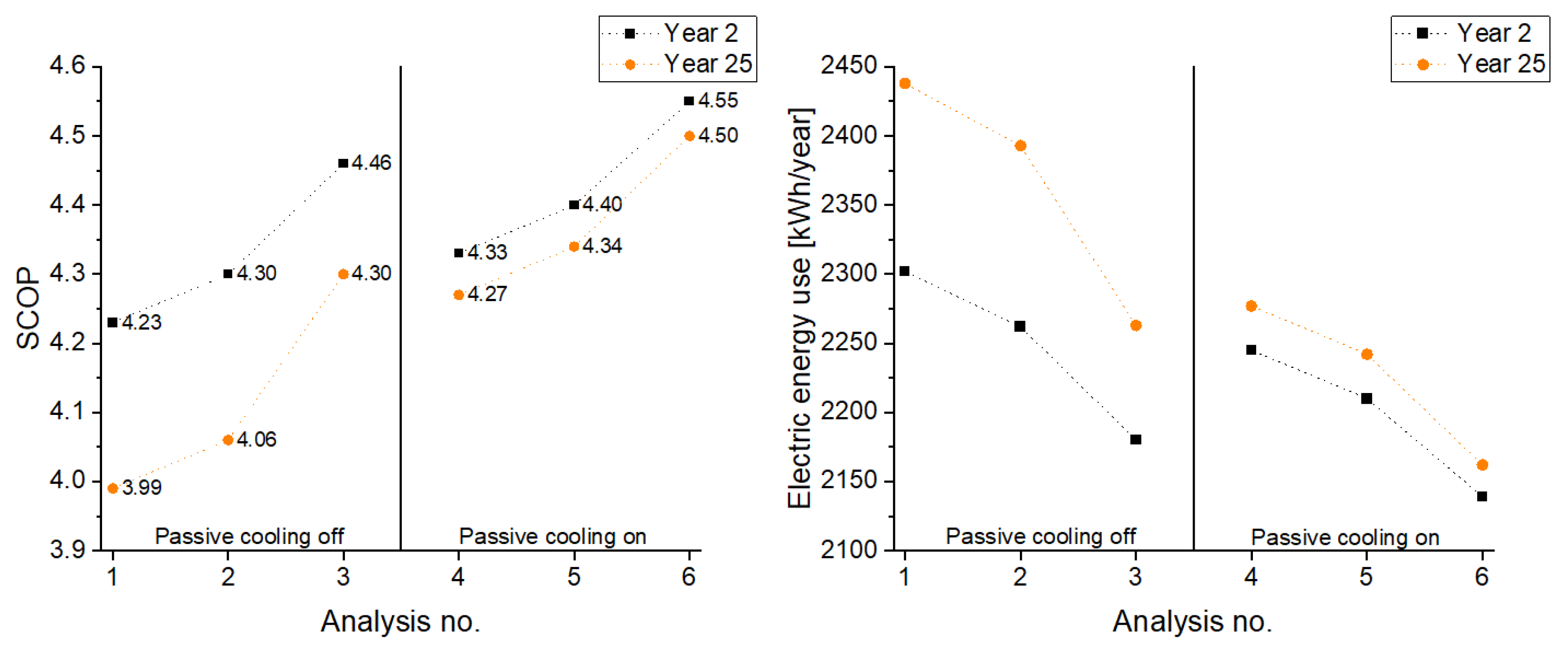
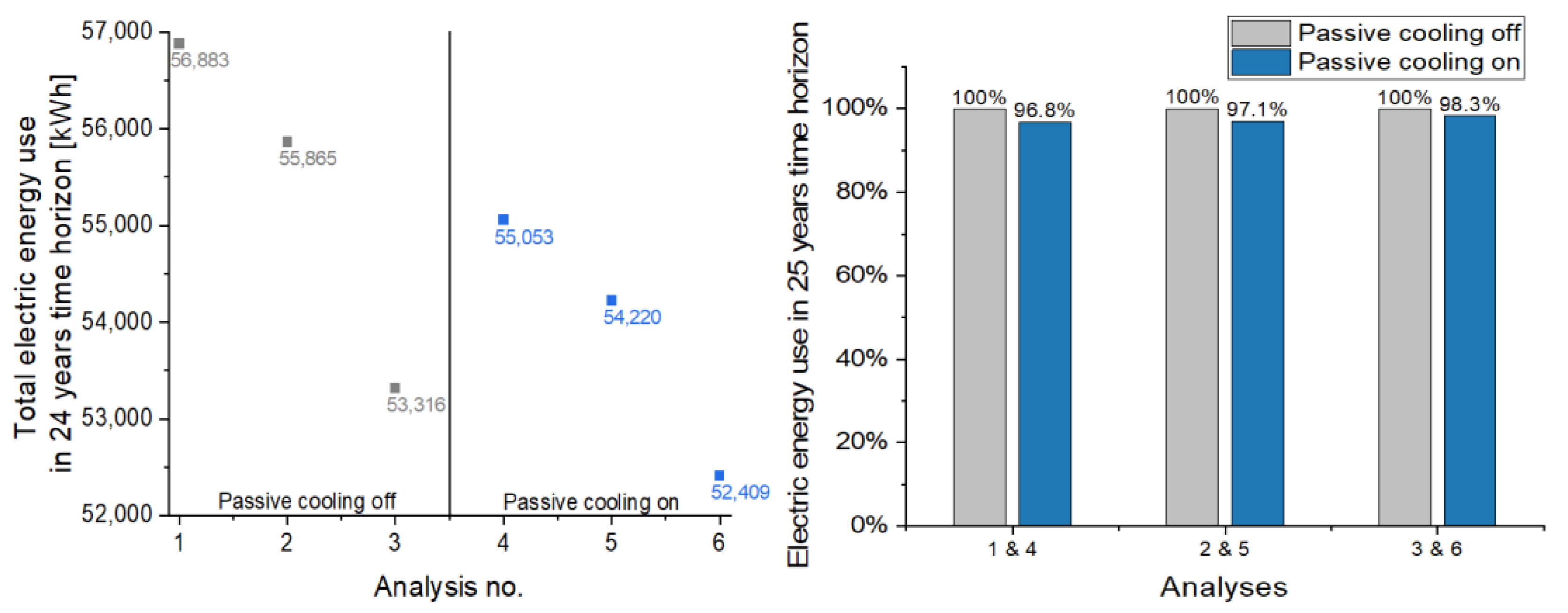
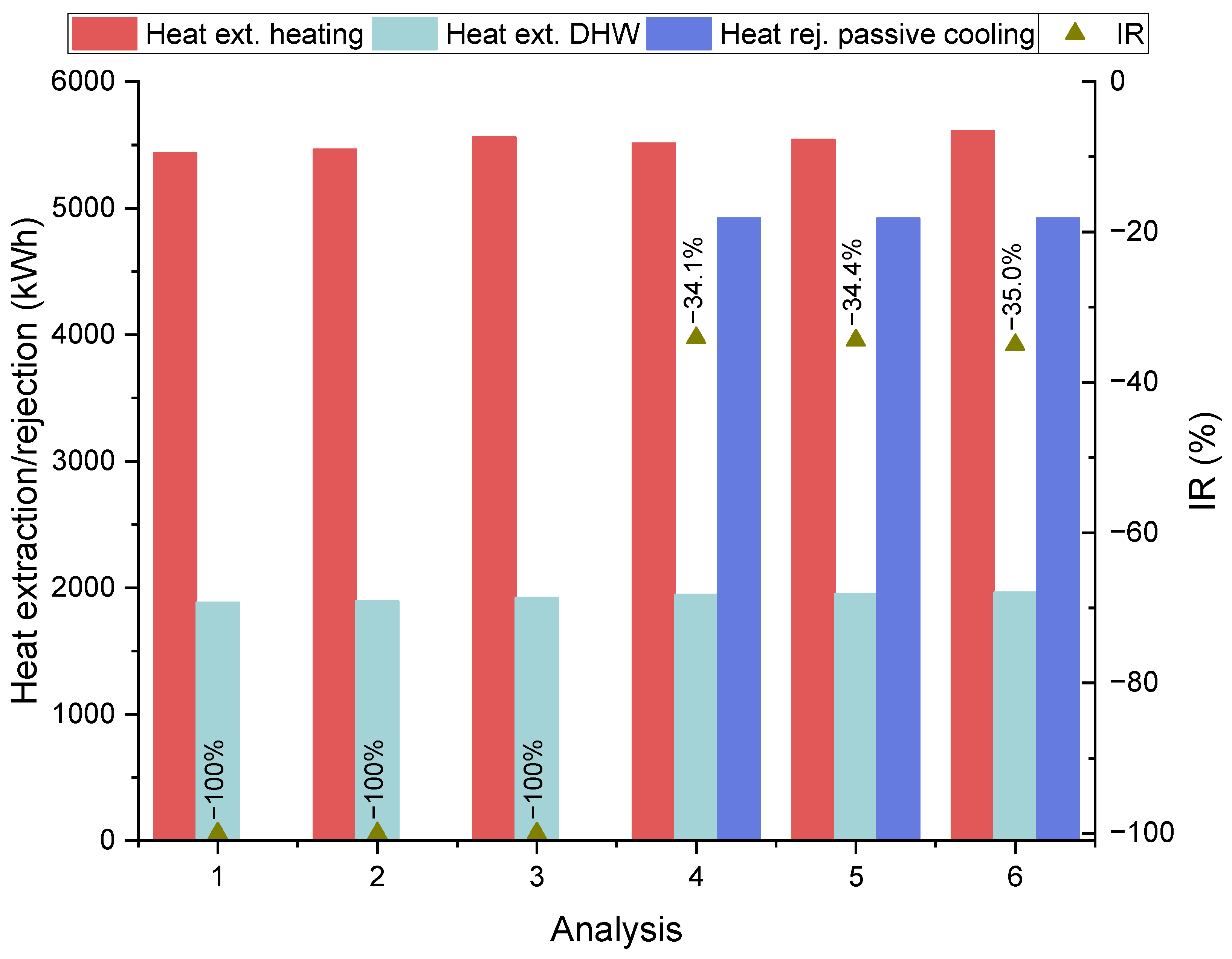
| Parameter | Data |
|---|---|
| Localization | Wrocław, Poland 17°02′ E, 51°06′ N |
| Type | Residential |
| Heat load | 6 kW |
| Heated area | 203 m2 |
| Heated cubature | 518 m3 |
| Heating system | Underfloor heating |
| Cooling system | Underfloor cooling |
| Ventilation | Mechanical supply and exhaust ventilation with energy recovery |
| Heat source | Ground source heat pump (brine/water) |
| Occupants | 8 |
| Floors | 2 |
| DHW preparation | Yes, with GSHP |
| DHW demand | 2759 kWh/year |
| Heating demand | 6976 kWh/year |
| Cooling demand | 4920 kWh/year |
| Indoor air temperature | 20–25 °C |
| Ground | Ground surface temperature | 8.3 °C |
| Geothermal heat flux | 0.06 W/m2 | |
| Borehole | Spacing | 6 m |
| Type | Single U | |
| Diameter | 110 mm | |
| Piping | Diameter | 32 × 2.9 mm |
| Conductivity | 0.41 W/(m·K) | |
| Spacing | 70 mm | |
| Ground Heat Exchanger Fluid | TYFOCOR concentration | 25 % |
| Conductivity | 0.47 W/(m·K) | |
| Specific heat | 3850 J/(kg·K) | |
| Density | 1044 kg/m3 | |
| Viscosity | 0.004 kg/(m·s) | |
| Freezing temperature | −12.3 °C | |
| Single pipe flow | 0.19 L/s |
| Properties | Basic Characteristics | Better Characteristics | |
|---|---|---|---|
| Ground | Ground conductivity Heat capacity | 1.0 W/(m·K) 1.5 MJ/(m3·K) | 1.5 W/(m·K) 2.4 MJ/(m3·K) |
| Borehole | Grout conductivity | 0.6 W/(m·K) | 2.0 W/(m·K) |
| Analysis No | Ground | Borehole Filler | Passive Cooling |
|---|---|---|---|
| 1 | Basic Characteristics | Basic Characteristics | Off |
| 2 | Basic Characteristics | Better Characteristics | Off |
| 3 | Better Characteristics | Better Characteristics | Off |
| 4 | Basic Characteristics | Basic Characteristics | On |
| 5 | Basic Characteristics | Better Characteristics | On |
| 6 | Better Characteristics | Better Characteristics | On |
| Pollutant | Amount [kg/MWh] |
|---|---|
| CO2 | 698 |
| SO2/SOx | 0.509 |
| NO2/NOx | 0.522 |
| CO | 0.203 |
| Particulate Matter | 0.026 |
| Analysis No | Absolute SCOP Value Drop in 24 Years | Ratio of SCOP Value Drop |
|---|---|---|
| 1 | 0.24 | 5.67% |
| 2 | 0.24 | 5.58% |
| 3 | 0.16 | 3.59% |
| 4 | 0.06 | 1.38% |
| 5 | 0.06 | 1.36% |
| 6 | 0.05 | 1.10% |
| Pollutant | Analyses | ||
|---|---|---|---|
| 1&4 | 2&5 | 3&6 | |
| CO2 | 1830 | 1701 | 1186 |
| SO2/SOx | 1.33 | 1.24 | 0.87 |
| NO2/NOx | 1.37 | 1.27 | 0.89 |
| CO | 0.53 | 0.49 | 0.35 |
| Particulate Matter | 0.07 | 0.06 | 0.04 |
Publisher’s Note: MDPI stays neutral with regard to jurisdictional claims in published maps and institutional affiliations. |
© 2022 by the authors. Licensee MDPI, Basel, Switzerland. This article is an open access article distributed under the terms and conditions of the Creative Commons Attribution (CC BY) license (https://creativecommons.org/licenses/by/4.0/).
Share and Cite
Fidorów-Kaprawy, N.; Stefaniak, Ł. Potential of CO2 Emission Reduction via Application of Geothermal Heat Exchanger and Passive Cooling in Residential Sector under Polish Climatic Conditions. Energies 2022, 15, 8531. https://doi.org/10.3390/en15228531
Fidorów-Kaprawy N, Stefaniak Ł. Potential of CO2 Emission Reduction via Application of Geothermal Heat Exchanger and Passive Cooling in Residential Sector under Polish Climatic Conditions. Energies. 2022; 15(22):8531. https://doi.org/10.3390/en15228531
Chicago/Turabian StyleFidorów-Kaprawy, Natalia, and Łukasz Stefaniak. 2022. "Potential of CO2 Emission Reduction via Application of Geothermal Heat Exchanger and Passive Cooling in Residential Sector under Polish Climatic Conditions" Energies 15, no. 22: 8531. https://doi.org/10.3390/en15228531
APA StyleFidorów-Kaprawy, N., & Stefaniak, Ł. (2022). Potential of CO2 Emission Reduction via Application of Geothermal Heat Exchanger and Passive Cooling in Residential Sector under Polish Climatic Conditions. Energies, 15(22), 8531. https://doi.org/10.3390/en15228531






